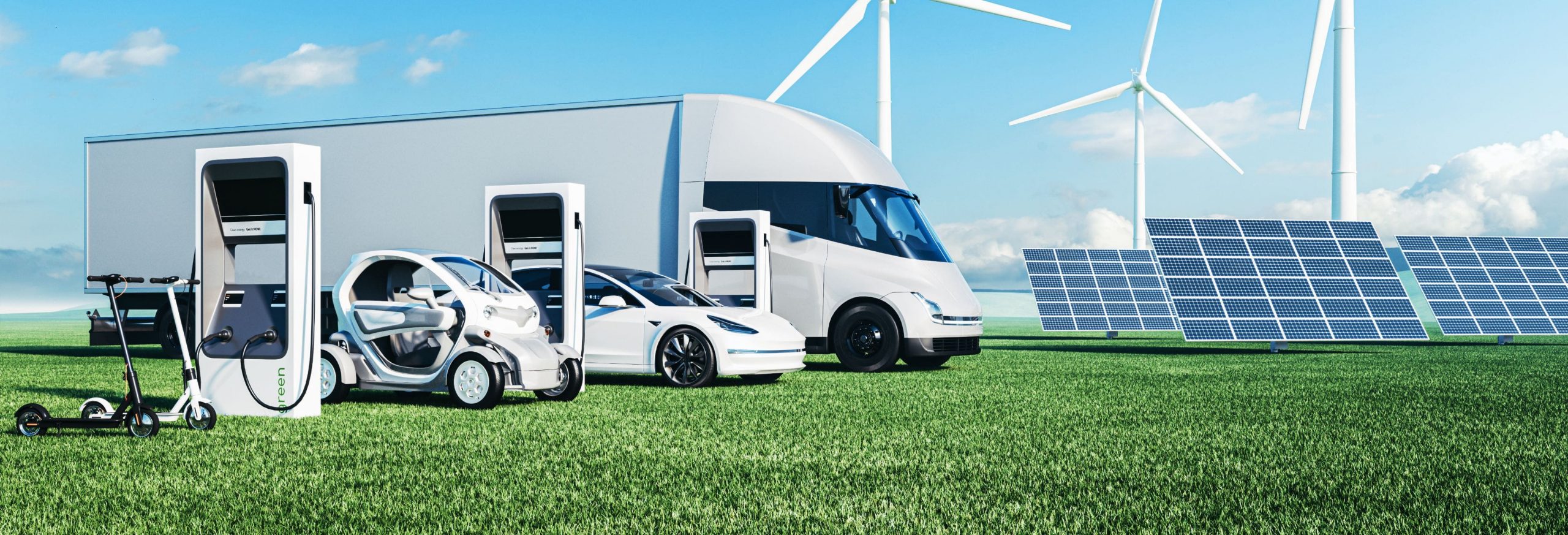
Worldwide Status of Electric Vehicles?Just 1% of Market in Japan!
How is Tokyo Century Group Working to Popularize Electric Vehicles?
Jun 15, 2022
The use of electric vehicles (EVs), which run on electric motors, represents more than simply demand for a new type of vehicle; they are expected to become widespread as a key means of reducing greenhouse gas emissions and addressing global energy issues.
But how popular are EVs in Japan and the rest of the world today? And what needs to be done to increase their use? In this article, we review the overall status of EV use and discuss Tokyo Century Group’s related initiatives.
Gasoline-Powered Vehicles Are Facing Virtual Elimination Amid the Shift from the Paris Agreement to a Green Growth Strategy

Let’s first consider the background behind the popularization of EVs.
Since the Paris Agreement*1 commenced in 2015, great strides have been made around the world toward realizing a decarbonized society. In Japan, Prime Minister Suga (at the time) declared in October 2020 the goal of achieving carbon neutrality by 2050, and in December of the same year, the Green Growth Strategy Through Achieving Carbon Neutrality in 2050 (Green Growth Strategy) was formulated. A number of initiatives are now underway to achieve this goal, including the promotion of EVs.
In his policy address in January 2021, Prime Minister Suga announced his intention to achieve 100% all-electric vehicle*2 sales by 2035. Subsequently, the revised Green Growth Strategy was released in June of 2021, which clearly stated that 100% of new car sales would be electric by 2035, effectively ending the future sale of gasoline-powered vehicles.
EVs are expected to become even more widespread in the future, but what exactly is the current status of their use in Japan and worldwide?
*1 A global framework for reducing greenhouse gas emissions effective from 2020. Specifically, it sets the long-term goal of keeping the increase in global average temperature to well below 2°C above pre-industrial levels and pursuing efforts to limit it to 1.5°C.
*2 Includes fuel cell vehicles (FCVs), plug-in hybrid vehicles (PHVs), and hybrid vehicles (HVs) in addition to EVs.
Stagnant Growth of EV Market Share in Japan, and Future Prospects

Vehicle Sales by Fuel Type (Passenger Cars)*3, published by the Japan Automobile Dealers Association, offers reference data for the EV market share in Japan. According to this source, Japan’s total new vehicle sales (passenger cars) in 2021 were approximately 2.4 million vehicles, with EVs accounting for 21,139, or about 0.9%, a particularly low level compared to other countries around the world.
Why has the popularization of EVs been proceeding so slowly in Japan?
There are several reasons, including high prices for vehicles, short cruising ranges, an inadequate charging infrastructure, and a highly competitive hybrid car market. At the same time, domestic car makers have been offering relatively few EVs that perform well and are reasonably priced.
It is worth noting that Toyota announced its Battery EV Strategy in December 2021 with the goal of rolling out 30 battery EV models by 2030, and a global sales target of 3.5 million units a year. Expectations are high for Japan’s largest automaker and the impact it will have on promoting EV use in Japan.
*3 Yearly historical data for Vehicle Sales by Fuel Type (Passenger Cars), published by the Japan Automobile Dealers Association:
http://www.jada.or.jp/data/month/m-fuel-hanbai/ (Written in Japanese)
What Is the EV Market Share in the U.S., Europe, and China?

Let’s take a look at global EV market shares and related issues in the U.S., Europe, and China.
<United States>
According to NADA Data 2021*4, published by the National Automobile Dealers Association, new vehicle sales (passenger cars, etc.) in the U.S. in 2021 were approximately 14.93 million units, of which EVs accounted for about 2.9%, indicating that EVs are more widespread in the U.S. than in Japan. The ratio of EVs to new vehicle sales increased from 1.6% in the previous year, and it seems that more and more people in the U.S. are opting for EVs.
One thing unique to the U.S. is that Tesla, Inc. continues to be the dominant EV maker, accounting for about 80% of new EV sales in the country. In 2021, the company’s market capitalization exceeded 1 trillion dollars, and a series of EV manufacturing ventures have been established one after another in the U.S. EV use would appear to be riding a tailwind, and EV market share will vary widely, depending on the number of EVs that Tesla sells.
*4 NADA Data 2021, published by the National Automobile Dealers Association (NADA):
https://www.nada.org/
<Europe>
According to the New Car Registrations by Fuel Type, European Union*5, published by the European Automobile Manufacturers’ Association (ACEA), EV sales (passenger cars) in 18 major European countries in 2021 were approximately 1.19 million units, a significant increase of 64% from the previous year. EVs also account for 11% of new car sales, with an overall share of more than 10%, larger than in both Japan and the U.S. What accounts for the rapid increase of EV use in Europe?
The main factor might be the high standards that have been set across Europe with the ultimate aim of achieving decarbonization. The European Commission’s European Green Deal legislation, for instance, has established strict standards for the automotive sector. The targets are to reduce greenhouse gas emissions by 55% from the 2021 level by 2030 and by 100% from the 2021 level by 2035.
What’s more, European countries offer generous incentives such as subsidies for EV purchases, and major European makers are enriching their EV lineups so consumers have more choices. These factors may also be driving the rapid expansion of EV market share.
*5 The New Car Registrations by Fuel Type, European Union, published by the European Automobile Manufacturers’ Association (ACEA):
https://www.acea.auto/files/20220202_PRPC-fuel_Q4-2021_FINAL.pdf
<China>
According to data*6 released by the China Association of Automobile Manufacturers (CAAM), new vehicle sales (passenger cars and commercial vehicles combined) in China increased for the first time in four years in 2021. Of the approximately 26.27 million new vehicles sold, EVs and other new energy vehicles had a particularly large impact.
In China, electrified vehicles, including EVs, plug-in hybrid vehicles (PHVs), and fuel cell vehicles (FCVs), are generally referred to as new energy vehicles (NEVs), and automakers are required to sell a certain number of these.
In 2021, approximately 3.52 million NEVs were sold, accounting for a year-on-year increase of 157% and roughly 13% market share of new vehicle sales. Of these, EVs represented about 2.91 million units, for 160% year-on-year growth, indicating that EVs are fast becoming popular.
The Hongguang MINI EV, a compact EV developed by SGMW, a joint venture between SAIC Motor, Liuzhou Wuling Motors and General Motors in China, is extremely popular in China. The main feature of the Hongguang MINI EV product line is that even the highest grade with an air conditioner costs around 600,000 yen*7, while the base model without an air conditioner costs less than 500,000 yen*7. This affordable price range*8 is a major reason for its popularity among the general public.
*6 China-Automotive sales volume, 2021, published by Automotive Industry Portal MARKLINES:
https://www.marklines.com/en/statistics/flash_sales/automotive-sales-in-china-by-month-2021
*7 Calculated at the exchange rate of 1 yuan = 15 yen at the time of launch (August 2020).
*8 Prices at initial launch in 2020
What Is Needed to Expand the EV Use in Japan?

We have reviewed the current status and background of the popularization of EVs in Japan and the rest of the world. Now, let’s examine what’s needed to further promote EV use domestically.
Many obstacles to widespread EV use are related to batteries. One factor driving up the price of EVs is the use of rare metals in the manufacture of lithium-ion batteries. There have also been persistent performance issues, such as long charging times and limited cruising ranges. Extending the range requires larger batteries and therefore higher prices and heavier vehicles.
To what extent market revitalization by major manufacturers will improve prices and performance remains to be seen. Technological advances and innovation, however, as well as the reuse of batteries and the establishment of a used battery market, may gradually resolve these issues.
An urgent issue is electricity security. If all Japanese automobiles were to be replaced by EVs, the power supply side must be strengthened to secure power for EVs.
Also, increased EV use must be accompanied by a greater share of renewable energy. No matter how successfully CO2 emissions from driving vehicles are reduced to zero through increased EV use, the result would be meaningless if the power for EVs, and reaching back even further─the power for manufacturing EVs, is generated by a method that emits large amounts of CO2.
The major weakness of conventional renewable energy sources, such as solar and wind power, has been unstable supply, depending on environmental conditions. The popularization of renewable energy will therefore depend on promoting the use of energy storage systems that can store electricity when a large amount is generated. In fact, EVs are also expected to be used as storage batteries. The idea is to use EVs as stationary storage batteries when the vehicle is not being used.
If this works, increased EV use will promote renewable energy, and the spread of renewable energy will further drive the development and dissemination of EVs, creating a virtuous cycle.

Tokyo Century Group intends to manage 100,000 EVs in the Mobility & Fleet Management segment (auto leasing for both corporate customers and individuals and rental cars) by 2030. Through Nippon Car Solutions Co., Ltd., which is handling auto leasing for corporate customers, the Group has launched an information service*9 on a trial basis to comprehensively support the introduction of EVs. The Group is also promoting initiatives to back up the popularization of EVs.
*9 The service provides customers with optimal EV fleets based on the analysis of the obtained driving data of their gasoline-powered vehicles as well as information such as estimated running costs and CO2 emission reductions as a result of optimizing the timing for charging.
In February 2022, Nippon Car Solutions and Nippon Rent-A-Car Service, Inc., which is handling the car rental business, launched a new initiative for an EV rental in cooperation with Kyushu Electric Power Company, Incorporated, offering an EV to the company as a business vehicle on weekdays and to general customers as a rental on weekends and holidays. Tokyo Century Group has long focused on environmental and energy businesses, including solar power generation, and is now verifying the effective use of renewable energy by combining its large solar power plant in the Kyushu region with the rental EV storage battery function.
Furthermore, Tokyo Century has concluded a capital and business alliance agreement with MIRAI-LABO Co., Ltd., which possesses innovative technology for the diagnostic assessment and reuse of EV batteries. The circular business model, with an emphasis on batteries, is steadily advancing in the automobile business.
Through these initiatives, we hope to contribute to the promotion of EVs in Japan and the creation of an environmentally sound, sustainable economy and society.
*The contents of the article and the position titles are as of the date posted.
RECOMMEND ARTICLES

Dec 20, 2023
New risk factors hav…

—Employees Encouraged by Family Ties and Understanding of Their Work
Oct 19, 2023
Every August since 2…

Feb 22, 2023
With its founding bu…





